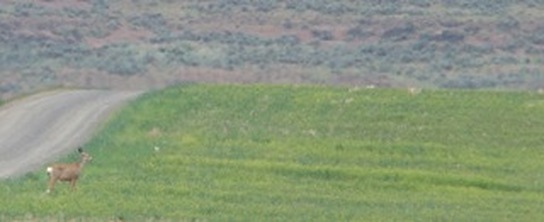
For a printable version of the newsletter, click here.
Greetings again from your Einkorn.
It’s March, so let’s go for a walk across the field redolent of lingering winter moisture, the soil’s breath fertile pungency. Counterpoint the clean gleam of sparkling dew on green tufts in the furrows that lead into the morning sun at Lentz Spelt Farms. Birdsong, nature’s renewal.
Not long after sunrise the Columbia Plateau siphons winds, winds tumbling from the still-icy Cascade ranges to race against a horizon all of a sudden broad; in a huff, these winds, at other times gliding, they stir the air over the furrows.
But it’s the sun climbing toward the equinox that wakes the grass from winter slumber. What a force, each plant spreading up and out to gain surface to the sky, growth upon growth, a symphony swelling with each lengthening day: a stand of winter grain in spring is one huge solar collector.
Adjacent, in the coulees and where the ground’s shallow, native shrubstepe: several species of sage and rabbit brush form the shrub matrix, bunchgrass makes up the steppe. Bunchgrass claims its place on sandy ground that’s so dry most of the year that the bunches grow at distance from one another, allowing for open ground and some wildflowers. Thus bunchgrass appears like so many individuals of a loosely knit plant community, whereas the cereal grass growing shoulder to shoulder acts as a dense population in a concert directed by those farmer furrows.
In the rain shadow of the Cascades, the Inland Northwest consists mostly of wheat land because cereal grains are better able to grow at low precipitation than other crops. About 3.5 million acres of the region, including the Lentz farm, lie in a half-moon-shaped area classified on agricultural maps as low-rainfall dryland, receiving a meager 6 inches to 12 inches average annual precipitation. This half-moon stretches from north-central Oregon east and north to Adams County, Ritzville, then bends westerly through some of Lincoln County and into Douglas County.
Most precipitation arrives here in winter, so if you see a farmer with a long spade or the T of a soil probe in a field, you know he’s checking the spring moisture. If the ground’s wet three feet down this time of year, the stand will produce alright; if moisture seeped as deep as five feet the crop has an unusually good start – that’s how far down the ever-so-slender feeder roots are able to push.
The farmer walking the field will calculate what percentage of a full stand he has after the winter, and for what yield he can hope. Of course this hope is couched in knowledge of a hundred adverse contingencies possible between now and harvest. Still, the hope’s there: optimism is a quintessential farmer trait that comes to the fore in spring. Anything else would be a hex.
Ah, but farmers. Remember the wise old women we spoke about, the ones wanting to coax the non-shattering subpopulations of Einkorn and Emmer. Once they were successful in saving seed for planting, groups of women would share the work of seeding. Historians mention dibble sticks with which holes were poked in the ground for the seed; this is easy to imagine in the case of the first vegetable crops, but to plant even a very small field of cereal grain by poking holes, no, we don’t see that. More likely they just scattered the seed on top of the ground, having observed the function of the grain head beards – the awns –, they exist to spur the spikelet into the soil.
We must remember that many first farms in the Fertile Crescent took advantage of rivers’ spring flooding that cleared some of the ground while depositing nutrient-rich mud. Later, after the men had domesticated and harnessed draft beasts, further lands were plowed. From that point on it was mostly men who did the farming in the regions where Einkorn spread.
Of course these first farmers proudly thought they’d learned to make extended use of plants. But from Einkorn’s perspective it’s the humans who’re being used to further the goal that every plant sort holds in common – species spread.
In effect, agriculture ushered in a new dimension for species spread. Plant responses varied. We’ve already talked about mutation and mimicry, about mice getting in on the coevolution act; now we must address the stalker. An Aegilops species called goatgrass began dogging cereal crops early on; not inclined to mimicry as was rye, goatgrass persistently crossed with Emmer to spread its species by proxy, so to speak. The plot worked, not once but several times, at least twice the cross resulted in Spelt of which the Carpathian offspring would become progenitor of the Spelts of Europe. Again there was a change in chromosomes: Triticum spelta is a hexaploid with 42 chromosomes, 28 more than Einkorn, 14 more than Emmer.
In a later era goatgrass and Emmer crossed again, and this time the offspring was Triticum aestivum, the free-threshing bread wheat we know so well, also a hexaploid.
Goatgrass is still stalking, still hybridizing with winter wheat; especially in the Midwest it ranks a major weed today.
Ancient Spelt spread into Europe where in regions of Germany, Switzerland and Austria it reigned as the predominant cereal crop all the way into the 19th century. In the state of Württemberg in southern Germany, for example, bread grain production measured 500,000 acres of Spelt versus a mere 30,000 acres of wheat in the mid-1800s.
Elsewhere in Europe, Spelt continued to be farmed as a crop secondary to free-threshing wheat.
Spelt’s decline was heralded by industrialization. As a hulled grain like Emmer and Einkorn, Spelt could not compete with free-threshing wheat in mass-production efficiency (with wheat no dehulling was necessary). American Spelt farming plummeted from 600,000 acres in the early 1900s, to an obscurity so dark that farmers themselves forgot the crop completely. When the Lentz farm grew their first Spelt crops at the turn of the century, it was not unusual for some curious farmer to stop and ask, “What is this crop?” “It’s Spelt.” “Smelt, you say?” “No, smelt is a fish. This is Spelt.”
In Europe, the catalyst for Spelt resurgence was a revival of teachings by St Hildegard von Bingen, the 12th-century abbess, visionary and healer whose mystique is quite contemporary, just last year Pope Benedict (who’s German) affirmed her sainthood church-wide and named her a Doctor of the Church, a very rare honor. Of the several books Hildegard dictated to a scribe, Physica and Causae et Curae deal with medicine. She was particularly convinced that Spelt is the Healing Grain.
This is well reflected in a Hildegard Laden (think: small health food store with a New Age twist) in Ansbach, Germany. Spelt berries and flakes and flour and bread and noodles beckon in various organic incarnations from top to bottom on a big shelf. We even spot “Hildegard Bowel Cleanser,” Spelt and chocolate two of the ingredients. Next a glass case with polished stones and crystals: Hildegard recognized their healing properties as well. And then two whole walls stocked with herbal products labeled with their German folk names (don’t ask). Books are also on sale, including one that discusses psychiatry from Hildegard’s perspective. In-between queue tasteful items, ceramics and hemp clothing and calming rock salt lights that gently round out the merchandise.
Shop owner Christine Schilhabel relates that she has a very personal connection to Hildegard’s teachings. At the age of two her son fell gravely ill; weakened by a stay in hospital, he regained his health when nursed according to Hildegard: “It was dramatic. I made him Spelt soup with Hildegard herbs and egg yolk. Hildegard wrote that the soup works like ‘an inner salve,’ and so it did. It made my son strong.”
Schilhabel had been exposed to Hildegard’s teachings through friends who’d undergone a big change in their lives not long before her toddler’s illness. After her son’s astonishing recovery she kept reading modern interpretations of Hildegard’s works until she became something of an expert herself – many customers have turned to her for dietary advice since she opened her store 15 years ago.
“It’s not just which herbs to use, but which herbs and foods not to use,” she says. For example, the advice is to abstain from leeks in spice mixtures; tomatoes are also best avoided because they belong to the nightshade family. “The best success comes from following Hildegard’s teachings in their entirety. She counsels to ‘lead your life with the right measure in all things’.”
Historically, church-political ploy was part of the story: even though several popes and the Holy Roman Emperor Frederick Barbarossa found it rewarding to communicate with Hildegard, the bishops of nearby Mainz obscured her teachings, Schilhabel says. People along the Rhine revered Hildegard after her death at 81, remembering her healing arts, otherwise she was mostly forgotten until an Austrian doctor and a German pharmacist studied her medical books and deemed them important. “After the Second World War, the Austrian doctor went from farmstead to farmstead, from flour mill to flour mill, sourcing Spelt that could be used for seed.” The significance here is that Healing Grain was hard to find because Adolf Hitler had forbidden Spelt, she notes.
A small Spelt resurgence took place thanks to the good doctor, although it wasn’t until the 1970s that Spelt made its comeback in a big way in Germany. By then the revival of Hildegard teachings had a larger following, and, the health benefits of Vollkorn – whole grain – were returning to consumer consciousness as well: bakers say that whole grain products highlight the outstanding flavor of Spelt.
Culinary traditions also re-emerged in that decade, a backlash against the homogenized food culture enacted by industrialization. This leads us to Dinkelsbühl, a favorite stop on the Romantische Straße, which highway winds from the River Main to the Alps through landscapes and townships idyllic. Dinkelsbühl had the good fortune to be historically preserved by decree of King Ludwig I of Bavaria, in 1826; with its imposing city walls completely intact, its towers and churches and patrician houses proudly standing, Dinkelsbühl would be a gigantic movie set were it not for the fact that it’s very much a living city with about 6000 residents within the walls of the old town.
Greetings again from your Einkorn.
It’s March, so let’s go for a walk across the field redolent of lingering winter moisture, the soil’s breath fertile pungency. Counterpoint the clean gleam of sparkling dew on green tufts in the furrows that lead into the morning sun at Lentz Spelt Farms. Birdsong, nature’s renewal.
Not long after sunrise the Columbia Plateau siphons winds, winds tumbling from the still-icy Cascade ranges to race against a horizon all of a sudden broad; in a huff, these winds, at other times gliding, they stir the air over the furrows.
But it’s the sun climbing toward the equinox that wakes the grass from winter slumber. What a force, each plant spreading up and out to gain surface to the sky, growth upon growth, a symphony swelling with each lengthening day: a stand of winter grain in spring is one huge solar collector.
Adjacent, in the coulees and where the ground’s shallow, native shrubstepe: several species of sage and rabbit brush form the shrub matrix, bunchgrass makes up the steppe. Bunchgrass claims its place on sandy ground that’s so dry most of the year that the bunches grow at distance from one another, allowing for open ground and some wildflowers. Thus bunchgrass appears like so many individuals of a loosely knit plant community, whereas the cereal grass growing shoulder to shoulder acts as a dense population in a concert directed by those farmer furrows.
In the rain shadow of the Cascades, the Inland Northwest consists mostly of wheat land because cereal grains are better able to grow at low precipitation than other crops. About 3.5 million acres of the region, including the Lentz farm, lie in a half-moon-shaped area classified on agricultural maps as low-rainfall dryland, receiving a meager 6 inches to 12 inches average annual precipitation. This half-moon stretches from north-central Oregon east and north to Adams County, Ritzville, then bends westerly through some of Lincoln County and into Douglas County.
Most precipitation arrives here in winter, so if you see a farmer with a long spade or the T of a soil probe in a field, you know he’s checking the spring moisture. If the ground’s wet three feet down this time of year, the stand will produce alright; if moisture seeped as deep as five feet the crop has an unusually good start – that’s how far down the ever-so-slender feeder roots are able to push.
The farmer walking the field will calculate what percentage of a full stand he has after the winter, and for what yield he can hope. Of course this hope is couched in knowledge of a hundred adverse contingencies possible between now and harvest. Still, the hope’s there: optimism is a quintessential farmer trait that comes to the fore in spring. Anything else would be a hex.
Ah, but farmers. Remember the wise old women we spoke about, the ones wanting to coax the non-shattering subpopulations of Einkorn and Emmer. Once they were successful in saving seed for planting, groups of women would share the work of seeding. Historians mention dibble sticks with which holes were poked in the ground for the seed; this is easy to imagine in the case of the first vegetable crops, but to plant even a very small field of cereal grain by poking holes, no, we don’t see that. More likely they just scattered the seed on top of the ground, having observed the function of the grain head beards – the awns –, they exist to spur the spikelet into the soil.
We must remember that many first farms in the Fertile Crescent took advantage of rivers’ spring flooding that cleared some of the ground while depositing nutrient-rich mud. Later, after the men had domesticated and harnessed draft beasts, further lands were plowed. From that point on it was mostly men who did the farming in the regions where Einkorn spread.
Of course these first farmers proudly thought they’d learned to make extended use of plants. But from Einkorn’s perspective it’s the humans who’re being used to further the goal that every plant sort holds in common – species spread.
In effect, agriculture ushered in a new dimension for species spread. Plant responses varied. We’ve already talked about mutation and mimicry, about mice getting in on the coevolution act; now we must address the stalker. An Aegilops species called goatgrass began dogging cereal crops early on; not inclined to mimicry as was rye, goatgrass persistently crossed with Emmer to spread its species by proxy, so to speak. The plot worked, not once but several times, at least twice the cross resulted in Spelt of which the Carpathian offspring would become progenitor of the Spelts of Europe. Again there was a change in chromosomes: Triticum spelta is a hexaploid with 42 chromosomes, 28 more than Einkorn, 14 more than Emmer.
In a later era goatgrass and Emmer crossed again, and this time the offspring was Triticum aestivum, the free-threshing bread wheat we know so well, also a hexaploid.
Goatgrass is still stalking, still hybridizing with winter wheat; especially in the Midwest it ranks a major weed today.
Ancient Spelt spread into Europe where in regions of Germany, Switzerland and Austria it reigned as the predominant cereal crop all the way into the 19th century. In the state of Württemberg in southern Germany, for example, bread grain production measured 500,000 acres of Spelt versus a mere 30,000 acres of wheat in the mid-1800s.
Elsewhere in Europe, Spelt continued to be farmed as a crop secondary to free-threshing wheat.
Spelt’s decline was heralded by industrialization. As a hulled grain like Emmer and Einkorn, Spelt could not compete with free-threshing wheat in mass-production efficiency (with wheat no dehulling was necessary). American Spelt farming plummeted from 600,000 acres in the early 1900s, to an obscurity so dark that farmers themselves forgot the crop completely. When the Lentz farm grew their first Spelt crops at the turn of the century, it was not unusual for some curious farmer to stop and ask, “What is this crop?” “It’s Spelt.” “Smelt, you say?” “No, smelt is a fish. This is Spelt.”
In Europe, the catalyst for Spelt resurgence was a revival of teachings by St Hildegard von Bingen, the 12th-century abbess, visionary and healer whose mystique is quite contemporary, just last year Pope Benedict (who’s German) affirmed her sainthood church-wide and named her a Doctor of the Church, a very rare honor. Of the several books Hildegard dictated to a scribe, Physica and Causae et Curae deal with medicine. She was particularly convinced that Spelt is the Healing Grain.
This is well reflected in a Hildegard Laden (think: small health food store with a New Age twist) in Ansbach, Germany. Spelt berries and flakes and flour and bread and noodles beckon in various organic incarnations from top to bottom on a big shelf. We even spot “Hildegard Bowel Cleanser,” Spelt and chocolate two of the ingredients. Next a glass case with polished stones and crystals: Hildegard recognized their healing properties as well. And then two whole walls stocked with herbal products labeled with their German folk names (don’t ask). Books are also on sale, including one that discusses psychiatry from Hildegard’s perspective. In-between queue tasteful items, ceramics and hemp clothing and calming rock salt lights that gently round out the merchandise.
Shop owner Christine Schilhabel relates that she has a very personal connection to Hildegard’s teachings. At the age of two her son fell gravely ill; weakened by a stay in hospital, he regained his health when nursed according to Hildegard: “It was dramatic. I made him Spelt soup with Hildegard herbs and egg yolk. Hildegard wrote that the soup works like ‘an inner salve,’ and so it did. It made my son strong.”
Schilhabel had been exposed to Hildegard’s teachings through friends who’d undergone a big change in their lives not long before her toddler’s illness. After her son’s astonishing recovery she kept reading modern interpretations of Hildegard’s works until she became something of an expert herself – many customers have turned to her for dietary advice since she opened her store 15 years ago.
“It’s not just which herbs to use, but which herbs and foods not to use,” she says. For example, the advice is to abstain from leeks in spice mixtures; tomatoes are also best avoided because they belong to the nightshade family. “The best success comes from following Hildegard’s teachings in their entirety. She counsels to ‘lead your life with the right measure in all things’.”
Historically, church-political ploy was part of the story: even though several popes and the Holy Roman Emperor Frederick Barbarossa found it rewarding to communicate with Hildegard, the bishops of nearby Mainz obscured her teachings, Schilhabel says. People along the Rhine revered Hildegard after her death at 81, remembering her healing arts, otherwise she was mostly forgotten until an Austrian doctor and a German pharmacist studied her medical books and deemed them important. “After the Second World War, the Austrian doctor went from farmstead to farmstead, from flour mill to flour mill, sourcing Spelt that could be used for seed.” The significance here is that Healing Grain was hard to find because Adolf Hitler had forbidden Spelt, she notes.
A small Spelt resurgence took place thanks to the good doctor, although it wasn’t until the 1970s that Spelt made its comeback in a big way in Germany. By then the revival of Hildegard teachings had a larger following, and, the health benefits of Vollkorn – whole grain – were returning to consumer consciousness as well: bakers say that whole grain products highlight the outstanding flavor of Spelt.
Culinary traditions also re-emerged in that decade, a backlash against the homogenized food culture enacted by industrialization. This leads us to Dinkelsbühl, a favorite stop on the Romantische Straße, which highway winds from the River Main to the Alps through landscapes and townships idyllic. Dinkelsbühl had the good fortune to be historically preserved by decree of King Ludwig I of Bavaria, in 1826; with its imposing city walls completely intact, its towers and churches and patrician houses proudly standing, Dinkelsbühl would be a gigantic movie set were it not for the fact that it’s very much a living city with about 6000 residents within the walls of the old town.
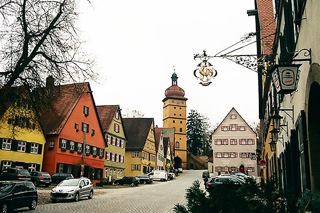
A walk on the cobblestones of Dinkelsbühl puts you in a time warp, with hundreds-years-old stone and wood beam construction surrounding – even the arm protruding under the gable, dangling rope that once yanked goods to the upper stories, even that arm has been left –, while in the narrow streets move cars with the latest computer technology blinking and shimmering in their interior, and some of the residents glueing cell phones to their ears. One thing is for sure, when house repairs are necessary the costs are sky high to maintain the historical authenticity as per ordinance.
In our context the name is pertinent – Dinkelsbühl means ”Spelt Knoll.”
In our context the name is pertinent – Dinkelsbühl means ”Spelt Knoll.”

It may or may not be a coincidence that the first document mentioning Dinkelsbühl dates the same century as Hildegard’s; earliest settlement evidence traces back to 730 A.D. Legend has it that a Spelt farmer gifted his homestead to wandering Karmeliter monks; a town grew up around the monks’ farm and chapel, and so the Spelt farmer counts as the founder of Dinkelsbühl. He’s immortalized in sculpture and mural, cradling a Spelt sheaf, a sickle in the other hand.
The monument’s sickle conjures up a small-farm aspect that holds true in the case of Günter Joas who farms Spelt on 25 acres in Dorf Oberwinstetten on the outskirts of Dinkelsbühl.
The monument’s sickle conjures up a small-farm aspect that holds true in the case of Günter Joas who farms Spelt on 25 acres in Dorf Oberwinstetten on the outskirts of Dinkelsbühl.
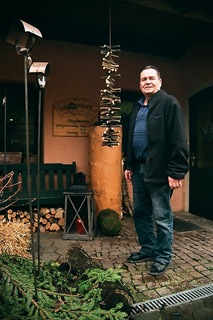
"Spelt brings people here," Joas says of his Grafenmichelhof where the country bakery is open three days a week; much of the baking here is to order. In summer months they cater events in the picturesque farmstead garden, serving traditional dishes prepared in an authentic wood oven. “Eat like God eats in Franconia,” is one official boast of Dinkelsbühl.
With acreage small even by Franconian standards, it made business sense to sell a good portion of his grain crops by way of baked goods, Joas notes, explaining that the open market for Spelt is highly variable.
"We grow Oberkulmer Rotkorn Spelt," he relates. "Before that I raised wheat and barley for the pork business I had then.” He was not a full-time farmer; now retired from his town job he leaves the farming mostly to his son-in-law.
With acreage small even by Franconian standards, it made business sense to sell a good portion of his grain crops by way of baked goods, Joas notes, explaining that the open market for Spelt is highly variable.
"We grow Oberkulmer Rotkorn Spelt," he relates. "Before that I raised wheat and barley for the pork business I had then.” He was not a full-time farmer; now retired from his town job he leaves the farming mostly to his son-in-law.
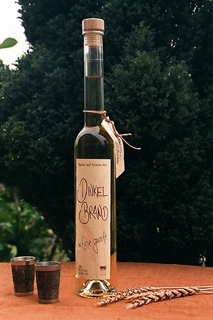
In addition to their breads, his oak-barrel-aged Dinkel Brand – Spelt whiskey, "Nature’s Noblest Sort” – also draws customers, Joas says.
The prognosis for ancient grains production looks bright, in terms of regional specialty products, Joas remarks, pointing to dark noodles on the shelf. These Spelt Rigatoni come from a group of growers who’ve banded together in their marketing, he says. Prominent is the Bioland (organic) emblem on the label, next to the relatively new European Union symbol for Öko (“eco”-logical) farming.
Europe’s Spelt revival was mirrored in America in the late 1980s, thanks largely to Purity Foods of Michigan who also invoked Hildegard in their initial promotions. One driver in the early-phase Spelt resurgence were the wheat allergies that had begun to affect a lot of Americans; it is still a market fact that Spelt serves as the preferred wheat alternative of allergy sufferers (however, it’s not recommended for celiacs).
Through the 1990s the specialty markets for Spelt and other ancestral grains broadened, which caused more scientists to pay attention to the trend. The most pertinent of their research was collected and published by the American Association of Cereal Chemists in 2005: Specialty Grains for Food and Feed thoroughly examines organic farming issues and the functionalities of a number of alternative grains.
In the book’s concluding chapter the editors note that lab tests confirm Spelt as a grain superior to wheat, however, the differences analyzed are not so great that they would by themselves account for what surveys of the Spelt-consuming public attest to, namely a general feeling of well-being as a result of eating Spelt. The editors deduce that a psychological effect must play a role.
Over 900 years earlier Hildegard had proclaimed this very aspect: consumption of Spelt, she wrote, leads to a sunny disposition.
The prognosis for ancient grains production looks bright, in terms of regional specialty products, Joas remarks, pointing to dark noodles on the shelf. These Spelt Rigatoni come from a group of growers who’ve banded together in their marketing, he says. Prominent is the Bioland (organic) emblem on the label, next to the relatively new European Union symbol for Öko (“eco”-logical) farming.
Europe’s Spelt revival was mirrored in America in the late 1980s, thanks largely to Purity Foods of Michigan who also invoked Hildegard in their initial promotions. One driver in the early-phase Spelt resurgence were the wheat allergies that had begun to affect a lot of Americans; it is still a market fact that Spelt serves as the preferred wheat alternative of allergy sufferers (however, it’s not recommended for celiacs).
Through the 1990s the specialty markets for Spelt and other ancestral grains broadened, which caused more scientists to pay attention to the trend. The most pertinent of their research was collected and published by the American Association of Cereal Chemists in 2005: Specialty Grains for Food and Feed thoroughly examines organic farming issues and the functionalities of a number of alternative grains.
In the book’s concluding chapter the editors note that lab tests confirm Spelt as a grain superior to wheat, however, the differences analyzed are not so great that they would by themselves account for what surveys of the Spelt-consuming public attest to, namely a general feeling of well-being as a result of eating Spelt. The editors deduce that a psychological effect must play a role.
Over 900 years earlier Hildegard had proclaimed this very aspect: consumption of Spelt, she wrote, leads to a sunny disposition.
© 2013 Lentz Spelt Farms

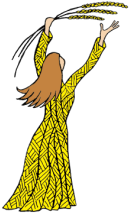
 RSS Feed
RSS Feed